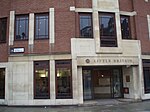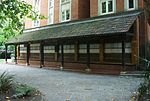Museum of London

The Museum of London documents the history of the UK's capital city from prehistoric to modern times. It is located in the City of London on the London Wall, close to the Barbican Centre and is part of the Barbican complex of buildings created in the 1960s and 1970s to redevelop a bomb-damaged area of the city. The museum is the largest urban history collection in the world, with more than six million objects.The museum is a few minutes' walk north of St Paul's Cathedral, overlooking the remains of the Roman city wall and on the edge of the oldest part of London, now its main financial district. It is primarily concerned with the social history of London and its inhabitants throughout time. The museum is jointly controlled and funded by the City of London Corporation and the Greater London Authority. In March 2015, the museum announced plans to move from its Barbican site to nearby Smithfield Market. The move is contingent upon raising an estimated £70 million.
Excerpt from the Wikipedia article Museum of London (License: CC BY-SA 3.0, Authors, Images).Museum of London
London Wall, City of London
Geographical coordinates (GPS) Address Phone number Website External links Nearby Places Show on map
Geographical coordinates (GPS)
| Latitude | Longitude |
|---|---|
| N 51.517705555556 ° | E -0.096808333333333 ° |
Address
Museum of London
London Wall 150
EC2Y 5HN City of London
England, United Kingdom
Open on Google Maps









